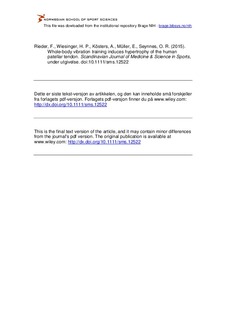| dc.contributor.author | Rieder, Florian | |
| dc.contributor.author | Wiesinger, Hans-Peter | |
| dc.contributor.author | Kösters, Alexander | |
| dc.contributor.author | Müller, Erich | |
| dc.contributor.author | Seynnes, Olivier R. | |
| dc.date.accessioned | 2016-08-25T08:40:17Z | |
| dc.date.available | 2016-08-25T08:40:17Z | |
| dc.date.issued | 2015-07-15 | |
| dc.identifier.citation | Scandinavian Journal of Medicine & Science in Sports. 2015, 26, 902-910 | nb_NO |
| dc.identifier.uri | http://hdl.handle.net/11250/2401586 | |
| dc.description | I Brage finner du siste tekst-versjon av artikkelen, og den kan inneholde ubetydelige forskjeller fra forlagets pdf-versjon. Forlagets pdf-versjon finner du på onlinelibrary.wiley.com / In Brage you'll find the final text version of the article, and it may contain insignificant differences from the journal's pdf version. The definitive version is available at onlinelibrary.wiley.com | nb_NO |
| dc.description.abstract | Animal studies suggest that regular exposure to whole-body vibration (WBV) induces an anabolic response in bone and tendon. However, the effects of this type of intervention on human tendon properties and its influence on the muscle-tendon unit function have never been investigated. The aim of this study was to investigate the effect of WBV training on the patellar tendon mechanical, material and morphological properties, the quadriceps muscle architecture and the knee extension torque–angle relationship. Fifty-five subjects were randomized into either a vibration, an active control, or an inactive control group. The active control subjects performed isometric squats on a vibration platform without vibration. Muscle and tendon properties were measured using ultrasonography and dynamometry. Vibration training induced an increase in proximal (6.3%) and mean (3.8%) tendon cross-sectional area, without any appreciable change in tendon stiffness and modulus or in muscle architectural parameters. Isometric torque at a knee angle of 90° increased in active controls (6.7%) only and the torque–angle relation remained globally unchanged in all groups. The present protocol did not appreciably alter knee extension torque production or the musculo-tendinous parameters underpinning this function. Nonetheless, this study shows for the first time that WBV elicits tendon hypertrophy in humans. | nb_NO |
| dc.language.iso | eng | nb_NO |
| dc.publisher | John Wiley & Sons Ltd | nb_NO |
| dc.subject | mechanical properties | nb_NO |
| dc.subject | material properties | nb_NO |
| dc.subject | strength | nb_NO |
| dc.subject | length–tension relationship | nb_NO |
| dc.title | Whole-body vibration training induces hypertrophy of the human patellar tendon | nb_NO |
| dc.type | Journal article | nb_NO |
| dc.type | Peer reviewed | nb_NO |
| dc.subject.nsi | VDP::Social science: 200 | nb_NO |
| dc.subject.nsi | VDP::Social science: 200::Social science in sports: 330 | nb_NO |
| dc.subject.nsi | VDP::Social science: 200::Social science in sports: 330::Other subjects within physical education: 339 | nb_NO |
| dc.source.journal | Scandinavian Journal of Medicine & Science in Sports | nb_NO |
| dc.identifier.doi | 10.1111/sms.12522 | |
| dc.description.localcode | Seksjon for fysisk prestasjonsevne / Department of Physical Performance | nb_NO |
